|
 Deutsche Version dieser Seite Deutsche Version dieser Seite |
|
|
|
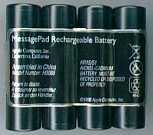 Ok, here are the instructions for refurbishing an Apple Newton MP 110 / 120 / 130 battery pack.
Today is definitely your lucky day: of the four packs there are in the Newton and eMate family this is the one that is by far the easiest and least costly to rebuild. No mysterious hidden
resistors inside and the replacements are standard AA size NiCd (Nickel Cadmium) rechargeables you will get for next to nothing at every other store. Ok, here are the instructions for refurbishing an Apple Newton MP 110 / 120 / 130 battery pack.
Today is definitely your lucky day: of the four packs there are in the Newton and eMate family this is the one that is by far the easiest and least costly to rebuild. No mysterious hidden
resistors inside and the replacements are standard AA size NiCd (Nickel Cadmium) rechargeables you will get for next to nothing at every other store. |
|
|
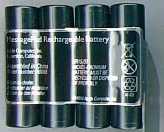 For this project the most crucial part comes right at the beginning. Patience! The thin wavy
aluminum metal plates that hold the pack together (from now on called TWAMPs) are glued to the cells with double sided tape. With sufficient patience you will be able to remove them
without tearing this tape to pieces and without bending the TWAMPs into a form you would regret ever after. The metal part you see at the right side of the pack is a knife. Insert it in the
gap between the metal part and the cell. Don’t cut anything, just use the knife as a lever. Pry the TWAMPs off slowly, alternatingly working from the left and the right side. And if I say
slowly, I mean slowly. For this project the most crucial part comes right at the beginning. Patience! The thin wavy
aluminum metal plates that hold the pack together (from now on called TWAMPs) are glued to the cells with double sided tape. With sufficient patience you will be able to remove them
without tearing this tape to pieces and without bending the TWAMPs into a form you would regret ever after. The metal part you see at the right side of the pack is a knife. Insert it in the
gap between the metal part and the cell. Don’t cut anything, just use the knife as a lever. Pry the TWAMPs off slowly, alternatingly working from the left and the right side. And if I say
slowly, I mean slowly.
Recently, someone told me a trick (which I haven't tried myself yet) that seems to make this a little easier. Take the battery
pack and toss it in the freezer overnight. An ice machine will do just fine, too. This will freeze the adhesive and allow you
to almost pop the TWAMPs off with very little prying. Once they heat back to room temperature, the glue returns to normal stickiness. |
|
|
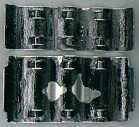 As you can see, I didn’t heed my own advice, thus parts of the tape came off. Put the TWAMPs in
a safe place for now, and make sure not to touch their inside as it is a good idea to avoid anything that might make them less sticky. Dispose of the old cells properly. As you can see, I didn’t heed my own advice, thus parts of the tape came off. Put the TWAMPs in
a safe place for now, and make sure not to touch their inside as it is a good idea to avoid anything that might make them less sticky. Dispose of the old cells properly. |
|
|
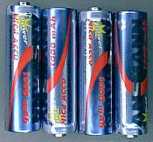 Get yourself four NiCd AA size rechargeables. These are the standard ones you will get just
about everywhere. Try to get cells with as much capacity as possible. State of the art these days is about 800 mAh. The beauties you see here have the amazing capacity of 1000 mAh which
everybody would have considered impossible not too long ago. Do not try to save some measly cents by not buying the highest capacity cells you can get your hands on. The additional time
those batteries will power your Newton more than outweighs the marginally higher cost. Do not, however, buy NiMH (Nickel Metal Hydride) cells although this may be tempting. I will
explain the reason in a minute. Get yourself four NiCd AA size rechargeables. These are the standard ones you will get just
about everywhere. Try to get cells with as much capacity as possible. State of the art these days is about 800 mAh. The beauties you see here have the amazing capacity of 1000 mAh which
everybody would have considered impossible not too long ago. Do not try to save some measly cents by not buying the highest capacity cells you can get your hands on. The additional time
those batteries will power your Newton more than outweighs the marginally higher cost. Do not, however, buy NiMH (Nickel Metal Hydride) cells although this may be tempting. I will
explain the reason in a minute. |
|
|
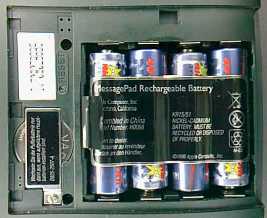 To reassemble the pack, the four cells need to be properly aligned. There are
various ways to do this, but by far the best one is to simply use your Newton. Put the new cells in and, if you are a perfectionist like I am, put some epoxy
along the edges where the cells touch. Make sure not to use too much, though, you neither want to glue them to your Newton’s battery compartment
nor do you want to impede getting the TWAMPs back on. Check twice that the polarity is correct and put the larger TWAMP back on. Push it onto the
cells with some force, but not too much as you don’t want to break anything in your precious Newton. If you accidently used the smaller TWAMP, now is
the time to pry everything out again and return to the beginning of the page. To reassemble the pack, the four cells need to be properly aligned. There are
various ways to do this, but by far the best one is to simply use your Newton. Put the new cells in and, if you are a perfectionist like I am, put some epoxy
along the edges where the cells touch. Make sure not to use too much, though, you neither want to glue them to your Newton’s battery compartment
nor do you want to impede getting the TWAMPs back on. Check twice that the polarity is correct and put the larger TWAMP back on. Push it onto the
cells with some force, but not too much as you don’t want to break anything in your precious Newton. If you accidently used the smaller TWAMP, now is
the time to pry everything out again and return to the beginning of the page. |
|
|
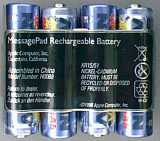 With only one of the TWAMPs attached, the pack is not yet as solid as it will be soon, so use
some caution when removing it from the Newton’s battery compartment. It helps to use a screwdriver as a lever to get the pack out in one piece. Once it looks like what you see here,
turn it around and attach the other TWAMP. Now is the time to apply a certain amount of force to ensure the TWAMPs will hold the pack together as safely as before. What I usually do
is put the pack on a flat surface (the tiles in your bathroom are perfect, the thick carpet in you living room is not), and put a book on top. Standing stork-like on the book for as long as my
impatience and my poor sense of balance allow (usually a couple of seconds) makes the pack nearly as solid as it was in the beginning. With only one of the TWAMPs attached, the pack is not yet as solid as it will be soon, so use
some caution when removing it from the Newton’s battery compartment. It helps to use a screwdriver as a lever to get the pack out in one piece. Once it looks like what you see here,
turn it around and attach the other TWAMP. Now is the time to apply a certain amount of force to ensure the TWAMPs will hold the pack together as safely as before. What I usually do
is put the pack on a flat surface (the tiles in your bathroom are perfect, the thick carpet in you living room is not), and put a book on top. Standing stork-like on the book for as long as my
impatience and my poor sense of balance allow (usually a couple of seconds) makes the pack nearly as solid as it was in the beginning. |
|
|
That is it. Not that difficult, was it? However, since I have put up this page a couple of people have asked me if I would do the refurbishing for them. The short answer is “Yes, I would.”
The
slightly more detailed answer is “Yes, I would - provided you are aware of the fact that, given the current exchange rate, the rechargeables will be about US$3.50 each over here in Germany. Shipping back
for up to three packs will be approximately US$7.00, and the fact that there are a couple of things I like even better than refurbishing battery packs will require that you shell out another US$7.00 for
my work.
This basically means that if all goes well, you will get back a pack that is nearly 50 percent better than the original for US$28.00 plus whatever it costs you to get the thing(s) to Germany.
If something goes wrong (which as yet hasn’t happened), you lose the pack and the cost of shipping to Germany.”
If all this doesn’t deter you, feel free to drop me a line.
|
|
|
What’s still missing is the explanation for my advice against using NiMH cells. The reason is that those cells require charge characteristics that are very different from what NiCd cells require. The
charge circuitry of the Newton 110 / 120 / 130 models was designed for charging NiCd cells and can’t provide the charge characteristics of NiMH batteries. Ignoring this would mean the NiMH cells would
never be charged in the way required to maintain their optimal perfomance, and there is a more-than-average chance that they would be harmed over time. Although some people have reported using NiMH cells
in these Newton models without any problems, I usually try to avoid taking chances.
|
|
|
Questions? Dead links? Anything unclear? Any syntax or grammatical errors in this description? Feel free to tell me about them. Yes, really. Don’t be polite, be helpful. If you aren’t, how am I supposed to improve my English?
Nothing like that? This page really helped you? Wow! What a perfect reason to sign my guest book...
Ready for the theory? You will find everything you ever wanted to know about rechargeables and a whole lot more here.
If you happen to be interested in reviews of books on batteries, rechargeables and charging concepts, please see my battery books page.?
|
|
|
|
|
|
|
|

